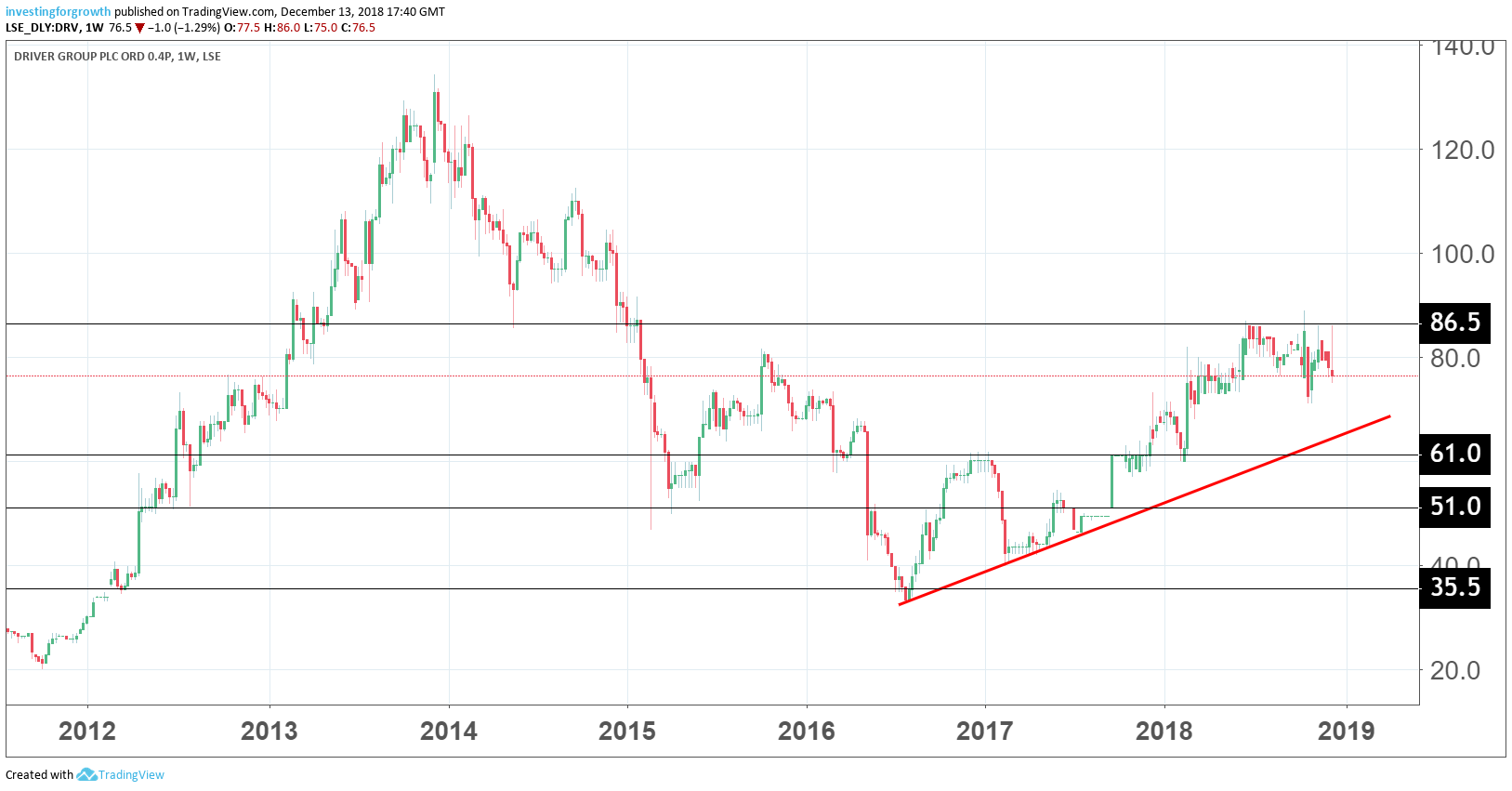Stockwatch: An AIM share to benefit from economic slowdown
14th December 2018 09:49
by Edmond Jackson from interactive investor
This small-cap is well-positioned and a turnaround is already firmly established. Companies analyst Edmond Jackson explains why this sound operation should deliver better growth.

Might £41 million Driver, the AIM-listed provider of dispute resolution services to the construction industry, be resistant to economic slowdown, even benefiting from increased demand?
Litigation cases tend to rise in a recession, according to AIM-listed litigation finance specialists Burford Capital, as realities surface and sentiments change, on an accumulation of work. In this context, Driver's latest results for its year to end-September show a profits rebound after under-performing businesses were sold, operations streamlined, amid a focus on core claims and disputes.
It also follows a change of chief executive mid-2016 and a new chief operating officer and two new non-executive directors in the first half of 2017, when Driver raised £8.5 million at 40p a share "to normalise the capital structure of the business and provide a solid platform to effect the remainder of the board’s recovery plan."
Overall robust operations, scope for Middle East to improve
Broadly a third of revenue is UK derived, the rest well-distributed internationally, thus making Driver potentially a beneficiary of weaker sterling where overseas revenues are translated into pounds and pence.
In terms of group divisions: Europe and the Americas rose 10% to £28.8 million with the UK doing particularly well also the Netherlands and German, and Canada said to be better positioned for the coming year after making a modest profit.
Asia Pacific has grown revenue the fastest - up 32% - though is the smallest at £1 million, driven by Singapore and Malaysia, with Australia enjoying a turnaround. Improvements in Hong Kong are said to offer opportunities in mainland China.
The Middle East has disappointed: United Arab Emirates' revenue down 22%, hence regional revenues down 9% to £22.9 million despite Qatar and Kuwait recording 35% and 29% growth respectively. Besides a new office in Kuwait City, a UAE marketing initiative has been held and "over the coming year we will seek to pursue a range of large projects." Time will tell, but at least initiatives are underway for turnaround.
The magnitude of Middle Eastern revenues temper near-term hope for double-digit annual group revenue, but if UAE issues are resolvable then Driver stands a decent chance of being perceived as a growth company. Management doesn't go into details of the UAE shortfall and, while it's an area generally offering opportunities for British business, I do come across examples of people experiencing trouble - thus a case of wait-and-see.
Management says the headwinds that affected the business 36 months ago "are now a thing of the past". They don't anticipate Brexit causing a significant impact on the group but equally don't explain how they are prepared. If disputes do increase with any lull in the construction industry however, this should enhance an overall supportive context.
Share-based payments: a crux for perception of value
Underlying pre-tax profit has soared 54% to £3.8 million, in line with a mid-October trading update that re-rated expectations against consensus for £2.7 million (also £2.9 million in respect of 2019), due to strong performance in the UK and "exceptionally good performances in Kuwait, Qatar and Singapore."
This is on revenue up a more modest 4% to £62.6 million, and an operating margin rising from 4.6% to 6.3% if you regard £1.1 million share-based payments as exceptional items, or if a genuine expense then the headline margin is more modest, rising from 2.5% to 4.6%. Good for recent profit, but really needs to keep improving – the table shows 8% achieved in 2013/2014 - otherwise greater revenue growth will be required to make investors pay attention.
Against a current market price of 77p the price/earnings (PE) ratio is 20 times diluted earnings per share (EPS) or, if you want to disregard share payments taking 28% of underlying operating profit, then "normalised" EPS is more like 6p, in which case a PE of 13x.

Source: TradingView (*) Past performance is not a guide to future performance
Each trading year at least a quarter of operating profit gets hived off this way, thus perception of value can hinge on whether they represent a genuine cost. Managers of listed plc's in professional services often seem to want to have their cake and eat it: that's the benefit of a public listing yet a profit-sharing private partnership also, with outside shareholders diluted in support of this.
It also contributes to undermine EPS comparisons with 2013/2014, around 9p being a tall order, henceforth now total shares issued have risen by about 80% since 2016 alone. That year's accounts showed an average 30 million shares, then in February 2017 a further 20 million were placed at 40p and there was also a 1 for 26 open offer.
Together with equity-based awards, total shares issued have recently approached 54 million, making it harder to bring down the PE if you regard it truthfully as nearer 20 than 13 times.
Moreover, the 16 October update said the non-cash share-based payment charge "may increase further as the board's expectation of future performance strengthen."
The board will doubtless say, share-based payments align interests between employees and shareholders, but such a culture didn't ensure resilience - e.g. profit falls in the 2015 and 2016 financial years, when market price was down to 33p.
| Driver Group - financial summary | ||||||
|---|---|---|---|---|---|---|
| year ended 30 Sep | 2013 | 2014 | 2015 | 2016 | 2017 | 2018 |
| Turnover (£ million) | 36.6 | 39.1 | 48.0 | 52.4 | 60.2 | 62.6 |
| IFRS3 pre-tax profit (£m) | 2.9 | 3.1 | -1.9 | -3.5 | 1.2 | 2.7 |
| Normalised pre-tax profit (£m) | 2.9 | 3.1 | 0.3 | -0.1 | 2.5 | 3.8 |
| Operating margin (%) | 8.1 | 8.0 | 0.8 | 0.2 | 2.5 | 4.6 |
| IFRS3 earnings/share (p) | 8.4 | 8.9 | -6.5 | -11.0 | 2.8 | 3.8 |
| Normalised earnings/share (p) | 8.4 | 8.9 | 0.2 | -0.7 | 5.4 | 6.1 |
| Earnings/share growth (%) | 78.0 | 6.0 | -97.3 | 13.0 | ||
| Price/earnings multiple (x) | 12.6 | |||||
| Annual average historic P/E (x) | 12.4 | 83.3 | 237 | 8.4 | 13.0 | |
| Cash flow/share (p) | 8.6 | -0.9 | -4.5 | -18.3 | 4.4 | |
| Capex/share (p) | 1.2 | 2.2 | 1.6 | 2.3 | 0.6 | |
| Dividends per share (p) | 1.2 | 1.6 | 1.7 | 1.1 | 0.0 | 0.5 |
| Covered by earnings (x) | 8.1 | 6.2 | 0.4 | 12.2 | ||
| Yield (%) | 0.6 | |||||
| Net tangible assets per share (p) | 24.3 | 30.9 | 20.5 | 11.1 | 24.4 | 30.6 |
Source: Company REFS Past performance is not a guide to future performance
Low dividend yield emphasises an earnings view
Dividends per share are similarly affected but, unless Driver wants to expand by acquisition, then a well-run consultancy is in principle the kind of business conducive to making shareholder returns. Latest financials show net cash generated from operations up 160% to £5.7 million, hence period-end cash up 103% to £10 million - in context of £3.1 million debt - on the balance sheet.
As yet the directors propose a mere 0.5p per share dividend costing £270,000, saying it "intends to pursue a progressive dividend policy to maximise shareholder value while retaining balance sheet flexibility to fund ongoing operating requirements."
That still means a high element of cover whichever way you look at earnings, backed by strong cash flow. Mind, that if the board is going to restore dividends only cautiously, it's fair to point out even a 1p per share payout would constitute a scant yield of 1.3% - leaving the stock exposed to the operations' narrative and EPS upshot.
Positive start to the new year if low visibility
The trend of improvements of the last year continue, hedged with a caution on predicting activity levels in a professional services business. However, "your board is confident that we can continue to build on the exceptional progress we have made so far...in every significant respect the company is in a far better position than it has been for several years."
So, while Driver may not yet add up to a "conviction buy", lacking demonstrable value, it now looks a sound operation able to deliver better growth, and is a useful candidate to mitigate inheritance tax via AIM-listed shares. On that criterion certainly: Buy.
*Horizontal lines on charts represent levels of previous technical support and resistance. Trendlines are marked in red.
Edmond Jackson is a freelance contributor and not a direct employee of interactive investor.
These articles are provided for information purposes only. Occasionally, an opinion about whether to buy or sell a specific investment may be provided by third parties. The content is not intended to be a personal recommendation to buy or sell any financial instrument or product, or to adopt any investment strategy as it is not provided based on an assessment of your investing knowledge and experience, your financial situation or your investment objectives. The value of your investments, and the income derived from them, may go down as well as up. You may not get back all the money that you invest. The investments referred to in this article may not be suitable for all investors, and if in doubt, an investor should seek advice from a qualified investment adviser.
Full performance can be found on the company or index summary page on the interactive investor website. Simply click on the company's or index name highlighted in the article.
Disclosure
We use a combination of fundamental and technical analysis in forming our view as to the valuation and prospects of an investment. Where relevant we have set out those particular matters we think are important in the above article, but further detail can be found here.
Please note that our article on this investment should not be considered to be a regular publication.
Details of all recommendations issued by ii during the previous 12-month period can be found here.
ii adheres to a strict code of conduct. Contributors may hold shares or have other interests in companies included in these portfolios, which could create a conflict of interests. Contributors intending to write about any financial instruments in which they have an interest are required to disclose such interest to ii and in the article itself. ii will at all times consider whether such interest impairs the objectivity of the recommendation.
In addition, individuals involved in the production of investment articles are subject to a personal account dealing restriction, which prevents them from placing a transaction in the specified instrument(s) for a period before and for five working days after such publication. This is to avoid personal interests conflicting with the interests of the recipients of those investment articles.